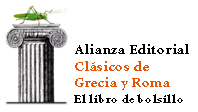ON A NEWLY DISCOVERED ACROSTIC IN VIRGIL (AEN. 10.693-697): MEZENTIUS AND JUPITERSobre un acróstico recientemente descubierto en Virgilio (Aen. 10.693-697): Mecencio y Júpiter
Neil Adkin
Resumen
Gabriela Marrón has very recently drawn attention to a new and important acrostic in Virgil: Iovis (Aen. 10.693‑697). The acrostic’s intentionality is confirmed by horizontally identical Iovis (l. 689). The present article endeavours to complement Marrón’s own paper in three main ways. In the first place, the article suggests that acrostical Iovis can shed light on Virgil’s puzzling statement that the notoriously sacrilegious Mezentius is acting here Iovis monitis (l. 689). Secondly, the acrostic would appear to elucidate the odd syntax of the ensuing simile and its application to Mezentius (693‑697). Thirdly and lastly, this article also endeavours to show that Virgil has inserted clues which tip the reader off to the presence of this acrostic. These hints are embedded in the text spanned by the acrostic itself as well as in the broader context. It can be shown that these Virgilian tip-offs conform to his customary practice in connection with acrostics.
Palabras clave: Virgilio; acróstico; Júpiter; Mecencio
Abstract
Gabriela Marrón ha llamado muy recientemente la atención sobre la presencia de un nuevo e importante acróstico en Virgilio: Iovis (Aen. 10.693‑697). La aparición horizontal del mismo término, Iovis (l. 689), confirma el carácter intencional de ese acróstico. El propósito de este trabajo es complementar el artículo de Marrón en función de tres cuestiones principales. En primer lugar, se sugiere que el acróstico Iovis puede iluminar la desconcertante afirmación de Virgilio acerca de que Mecencio, un personaje notoriamente sacrílego, actúa allí Iovis monitis (l. 689). En segundo término, el acróstico parece dilucidar la extraña sintaxis del símil siguiente y su aplicación a Mecencio (693‑697). En tercer y último lugar, este artículo también intenta mostrar que Virgilio insertó ciertas pistas que advierten al lector sobre la presencia de este acróstico. Se trata de indicios imbricados tanto en el texto que abarca el mismo acróstico, como en su contexto más amplio. Es posible demostrar que esas señales virgilianas se ajustan a las prácticas habituales del autor con relación a los acrósticos.
Keywords: Virgil; acrostic; Jupiter; Mezentius
Referencias bibliográficas
Bibliographic References
Adkin, N. (2007) «The Etymology of segnis in Virgil», AC 76, 171-176.
Adkin, N. (2014) «‘Read the Edge’: Acrostics in Virgil’s Sinon Episode», ACD 50, 45-72.
Adkin, N. (2016) «Acrostic Shit (Ecl. 4.47-52)», ACD 52, 21-37.
Adkin, N. (2018) «MA VE PU Again: Kill Caesar! (Georg. 1.424-471)», ACD 54, 73-90.
Adkin, N. (2020) «A Virgilian Onomastic (Aen. 6.641-657)», BStudLat 50, 482-497.
Adkin, N. (2021) «Virgilian Acrostics: A Typology», BStudLat 51, 128-136.
Adkin, N. (forthcoming) «Nisus and Euryalus: A Crux (Aen. 9.342-346)», RhM.
Austin, R.G. (1971) P. Vergili Maronis Aeneidos Liber Primus, Oxford, Clarendon [repr. 2001].
Bauer, H. (1912-1926) s.v. «finis», TLL VI,1, 786.45-799.61.
Conington, J. & Nettleship, H. (2008) Conington’s Virgil: Aeneid, Books X-XII, Exeter, Bristol Phoenix Press.
Conte, G.B. (20192) P. Vergilius Maro: Aeneis, Berlin/Boston, De Gruyter, DOI: 10.1515/9783110649031.
Dingel, J. (1997) Kommentar zum 9. Buch der Aeneis Vergils, Heidelberg, Winter.
Dittmann, G. (1936-1942) s.v. «h», TLL VI,3, 2389.1-2391.65.
Forbiger, A. (18754) P. Vergili Maronis Opera, vol. III, Leipzig, Hinrichs.
Forcellini, A. (1940) Lexicon Totius Latinitatis, vol. IV, Padua, Typis Seminarii.
Geymonat, M. (2008) P. Vergili Maronis Opera, Rome, Edizioni di Storia e Letteratura.
Hiltbrunner, O. (1931-1953) s.v. «expono», TLL V,2, 1756.32-1767.67.
Horsfall, N. (2003) Virgil, Aeneid 11: A Commentary, Leiden/Boston, Brill.
Lambertz, M. (1906-1909) s.v. «cornu», TLL IV, 962.36-973.68.
Lausberg, H. (20084) Handbuch der literarischen Rhetorik: Eine Grundlegung der Literaturwissenschaft, Stuttgart, Steiner.
Maltby, R. (1991) A Lexicon of Ancient Latin Etymologies, Leeds, Cairns [repr. Cambridge, 2006].
Marrón, G.A. (2019) «¿Un acróstico (más) en Virgilio? (Eneida 10.693-697)», Argos 43, no pagination, DOI: 10.14409/argos.2019.43.e0016.
Maurenbrecher, B. (1907) s.v. «c», TLL III, 1.1-2.54.
Page, T.E. (1900) The Aeneid of Virgil: Books VII-XII, London, Macmillan [repr. 1982].
Paratore, E. (1982) Virgilio: Eneide, vol. V, Rome/Milan, Mondadori [repr. 2008].
Paschalis, M. (1997) Virgil’s Aeneid: Semantic Relations and Proper Names, Oxford, Clarendon.
Ribbeck, O. (1857) «Mezentius: Beitrag zur lateinischen Grammatik», RhM 12, 419-425.
Rivero García, L. & Librán Moreno, M. (2011) «New Light on Virgil’s Mezentius: A New Homeric Model and Etymological Wordplay», Paideia 66, 457-489.
Robinson, M. (2019) «Looking Edgeways: Pursuing Acrostics in Ovid and Virgil», CQ 69, 290-308, DOI: 10.1017/S0009838819000375.
Saunders, C. (1940) «Sources of the Names of Trojans and Latins in Vergil’s Aeneid», TAPhA 71, 537-555.
Sidgwick, A. (1890) P. Vergili Maronis Opera, vol. II, Cambridge, University Press [repr. 1934].
Squillante Saccone, M. (1990) «Vis», in F. della Corte (ed.) Enciclopedia Virgiliana, vol. V*, Rome, Istituto della Enciclopedia Italiana, 568-569.
Ziogas, I. (2016) «Introduction: Power, Puns, and Politics from Horace to Silius Italicus», in P. Mitsis & I. Ziogas (eds.) Wordplay and Powerplay in Latin Poetry, Berlin/Boston, De Gruyter, 1-12.
Revista
-
Sobre la revista
Página principal
-
Estatutos
Estatutos de la Revista Estudios Clásicos
-
Código ético
Declaración de buenas prácticas
-
Normas de recepción y envío
Indicaciones para envíos de artículos
-
Equipo editorial
Consejos de redacción y asesor
-
Comité de honor
Comité de honor
Información
-
Para autores
Publicar con nosotros
-
Para evaluadores
Normas para evaluar artículos
-
Para bibliotecas
Información bibliográfica
-
Contacto
Cuestiones y preguntas
Publicar en EClás
-
Envío de originales
Artículos y reseñas
-
Normas de publicación
Descarga normas en PDF
-
Estilo CSL EClás
Estilo CSL EClás
-
Índices de calidad
Bases de datos e impactos


 c/ Serrano, 107
c/ Serrano, 107